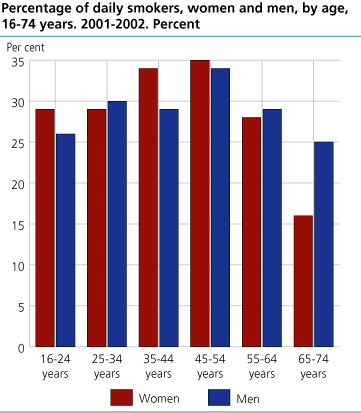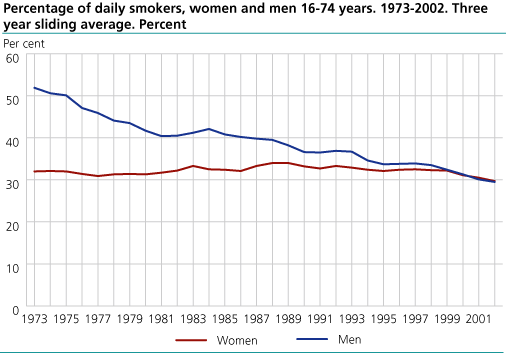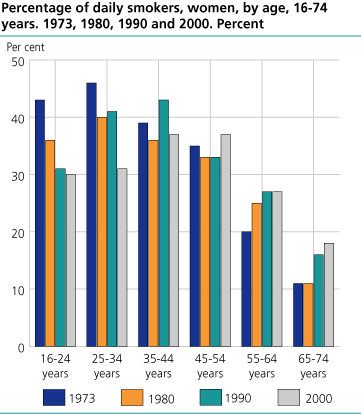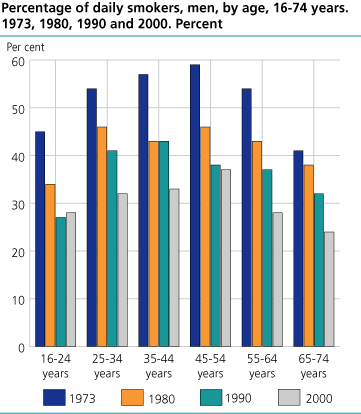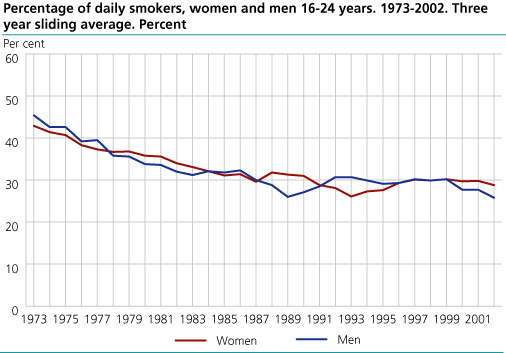Content
Published:
This is an archived release.
29 per cent daily smokers
A good 29 per cent of the Norwegian adult population smoked daily in 2002. In addition, approximately 12 per cent smoked occasionally. The survey covers the population aged 16 to 74 years.
Each year, four separate surveys are carried out by Statistics Norway. These surveys have a total net sample of more than 5000 persons. They show that 29,4 per cent of the population aged 16 - 74 years old are daily smokers. There is only a small difference between sexes. 28,8 per cent of the men, and 30,0 per cent of the women say that they are daily smokers. This difference is not statistically significant. Smoking prevalence is highest among those aged 35 - 54 years, and lowest among the younger and the elderly.
Patterns of smoking measured by Statistics Norway for 30 years
SSB has conducted surveys on use of tobacco for 30 years, and the portion of smokers is measured trough two separate questions. These are "Does it occur that you smoke?" and "Do you smoke daily or occasionally?" In 1973, more than half of the male population (51 per cent) were smokers. Today, the portion is approximately 29 per cent. Since 1973, the portion of daily smokers among women has been a bit more than 30 per cent. The difference between sexes is gone, and there are now equal portions of daily smokers among both men and women.
In any survey, there are possible sources of error. Also, in a sample of 5000 persons, which is relatively large, one has error margins of more than one per centage point both ways. To counteract the effect of random changes in the data - especially in diagrams as figure 2 - one often uses a so-called three years sliding average. This has been of particular importance in periods where the sample has been smaller than it is today. A three years sliding average means that one calculates the average of the result for the consecutive years, and let this represent the year in the middle of these three. Table 1 shows the effect of this.
Fewer young and more elderly female smokers
Looking at figure 2 it may seem as if males stop smoking more frequently than women. This is not necessarily the case, since the portion of female smokers never became equal to the portion of male smokers in the 1970s. The composition in age among female smokers has changed significantly since Statistics Norway started its surveys on smoking prevalence. There are now fewer young and more elderly female smokers, as shown in figure 4. If we take a look at the portion of daily smokers among both men and women aged 16-24 years, sliding average (figure 3), we can see that the changes among both men and women are quite similar. This may indicate that females do not start to smoke, or they stop smoking, just as frequently as males, even though the total portion of smokers among females has been relatively stable. In other words, the pattern of smoking among women has become more equal to the pattern among men.
The statistics is carried out each year on behalf of Directorate for Health and Social Affairs
|
Percentage daily and occasional smokers, 16-74 years. 1998-2002. Observed result and
estimated three-year sliding average |
| Year | Daily smoker | Occasional smoker | |||||||||||||||||||||||||||||||||||||
|---|---|---|---|---|---|---|---|---|---|---|---|---|---|---|---|---|---|---|---|---|---|---|---|---|---|---|---|---|---|---|---|---|---|---|---|---|---|---|---|
| Observed result | Estimated three year sliding average | Observed result | Estimated three year sliding average | Sample size (N) | |||||||||||||||||||||||||||||||||||
| 1998 | 33.0 | 32.9 | 11.0 | 11.5 | 5 088 | ||||||||||||||||||||||||||||||||||
| 1999 | 32.0 | 32.3 | 11.8 | 11.1 | 4 913 | ||||||||||||||||||||||||||||||||||
| 2000 | 31.9 | 31.2 | 10.6 | 11.2 | 5 004 | ||||||||||||||||||||||||||||||||||
| 2001 | 29.8 | 30.3 | 11.1 | 11.2 | 5 047 | ||||||||||||||||||||||||||||||||||
| 2002 | 29.4 | 129.6 | 11.8 | 111.5 | 5 311 | ||||||||||||||||||||||||||||||||||
| 1 | Average 2001 and 2002. |
Tables:
- Table 1 Percentage of daily smokers, by sex and age, 16-74 years. 2001-2002. Per cent
- Table 2 Percentage of daily smokers, 16-74 years, by sex. 1973-2002. Three year sliding average. Per cent
- Table 3 Percentage of daily smokers, 16-24 years, by sex. 1973-2002. Three year sliding average. Per cent
- Table 4 Percentage of daily smokers, by age and sex, 16-74 years. 1973, 1980, 1990 and 2000. Per cent
Contact
-
Elin Skretting Lunde
E-mail: elin.skretting.lunde@ssb.no
tel.: (+47) 92 42 70 07
-
Jorun Ramm
E-mail: jorun.ramm@ssb.no
tel.: (+47) 92 08 23 99
-
Arne Jensen
E-mail: arne.jensen@ssb.no
tel.: (+47) 99 71 22 45

